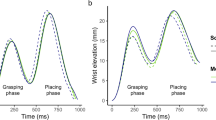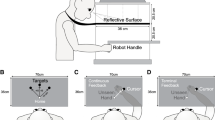Abstract
When reaches are performed toward target objects, the presence of other non-target objects influences kinematic parameters of the reach. A typical observation has been that non-targets positioned ipsilaterally to the acting limb interfere more with the trajectory of the hand than contralateral non-targets. Here, we investigate whether this effect is mediated by motor lateralization or by the relative positioning of the objects with reference to the acting limb. Participants were asked to perform reaches toward physical target objects with their preferred or non-preferred hands while physical non-targets were present in different possible positions in the workspace. We tested both left-handers and right-handers. Our results show that a participant’s handedness does not influence reaching behavior in an obstacle avoidance paradigm. Furthermore, no statistically significant differences between the use of the preferred and non-preferred hand were observed on the kinematic parameters of the reaches. We found evidence that non-targets positioned on the outside of the reaching limb influenced the reaching behavior more strongly than non-targets on the inside. Moreover, the type of movement also appeared to play a role, as reaches that crossed the workspace had a stronger effect on avoidance behavior than reaches that were ‘uncrossed.’ We interpret these results as support for the hypothesis that the avoidance response is determined by keeping a preferred distance between the acting limb in all stages of its reach toward the target and the non-target position. This process is not biased by hand dominance or the hand preference of the actor.





Similar content being viewed by others
Notes
Chapman and Goodale (2010) showed that avoidance responses were greater with one obstacle than with two obstacles. The fact that two obstacles were present in some studies means that the avoidance response in those cases might have been constrained. In bold strokes, the avoidance responses to a primary obstacle may have been smaller in order to properly avoid the secondary obstacle. We consider that although the magnitude of the avoidance response may have been smaller with two obstacles present the direction of the effect is still quite systematic, in that ipsilateral obstacles still evoke a stronger response than contralateral obstacles.
Unless specifically stated, otherwise all measures were computed from index finger marker data.
References
Annett J, Annett M, Hudson PTW, Turner A (1979) Control of movement in the preferred and non-preferred hands. Q J Exp Psychol-A 31:641–652
Ansuini C, Tognin V, Turella L, Castiello U (2007) Distractor objects affect fingers’ angular distances but not fingers’ shaping during grasping. Exp Brain Res 178:194–205. doi:10.1007/s00221-006-0723-0
Buckingham G, Carey DP (2009) Rightward biases during bimanual reaching. Exp Brain Res 194:197–206. doi:10.1007/s00221-008-1689-x
Carson RG, Goodman D, Chua R, Elliott D (1993) Asymmetries in the regulation of visually guided aiming. J Mot Behav 25:21–32. doi:10.1080/00222895.1993.9941636
Castiello U (1996) Grasping a fruit: selection for action. J Exp Psychol Human 22:582–603
Chapman CS, Goodale MA (2008) Missing in action: the effect of obstacle position and size on avoidance while reaching. Exp Brain Res 191:83–97. doi:10.1007/s00221-008-1499-1
Chapman CS, Goodale MA (2010) Seeing all the obstacles in your way: the effect of visual feedback and visual feedback schedule on obstacle avoidance while reaching. Exp Brain Res 202:363–375. doi:10.1007/s00221-009-2140-7
Cisek P, Kalaska JF (2010) Neural mechanisms for interacting with a world full of action choices. Annu Rev Neurosci 33:269–298
Cousineau D (2005) Confidence intervals in within-subject designs: a simpler solution to Loftus and Masson’s method. Tutor Quant Method Psychol 1(1):42–45
Dean J, Bruwer M (1994) Control of human arm movements in two dimensions: paths and joint control in avoiding simple linear obstacles. Exp Brain Res 97:497–514
Elliott D, Roy EA, Goodman D et al (1993) Asymmetries in the preparation and control of manual aiming movements. Can J Exp Psychol 47:570–589. doi:10.1037/h0078856
Feldman AG, Levin MF (2009) The equilibrium-point hypothesis—past, present and future. In: Sternad D (ed) Progress in motor control: a multidisciplinary perspective. Springer, New York, pp 699–726
Goble DJ, Brown SH (2008) The biological and behavioral basis of upper limb asymmetries in sensorimotor performance. Neurosci Biobehav R 32:598–610. doi:10.1016/j.neubiorev.2007.10.006
Meegan DV, Tipper SP (1998) Reaching into cluttered visual environments: spatial and temporal influences of distracting objects. Q J Exp Psychol-A 51A:225–249
Meegan DV, Tipper SP (1999) Visual search and target-direction action. J Exp Psychol Human 25:1–25
Menger R, Van der Stigchel S, Dijkerman HC (2012) How obstructing is an obstacle? The influence of starting posture on obstacle avoidance. Acta Psychol 141:1–8. doi:10.1016/j.actpsy.2012.06.006
Mon-Williams M, McIntosh RD (2000) A test between two hypotheses and a possible third way for the control of prehension. Exp Brain Res 134:268–273. doi:10.1007/s002210000479
Mon-Williams M, Tresilian JR, Coppard VL, Carson RG (2001) The effect of obstacle position on reach-to-grasp movements. Exp Brain Res 137:497–501. doi:10.1007/s002210100684
Mutha PK, Haaland KY, Sainburg RL (2013) Rethinking motor lateralization: specialized but complementary mechanisms for motor control of each arm. PLoS One 8(3):e58582. doi:10.1371/journal.pone.0058582
Pratt J, Abrams RA (1994) Action-centered inhibition: effects of distracters on movement planning and execution. Hum Movement Sci 13:245–254
Rice NJ, McIntosh RD, Schindler I et al (2006) Intact automatic avoidance of obstacles in patients with visual form agnosia. Exp Brain Res 174:176–188. doi:10.1007/s00221-006-0435-5
Roy E, Kalbfleisch L, Elliott D (1994) Kinematic analyses of manual asymmetries in visual aiming movements. Brain Cognition 24:289–295. doi:10.1006/brcg.1994.1017
Sainburg RL, Schaefer SY (2004) Interlimb differences in control of movement extent. J Neurophysiol 92:1374–1383. doi:10.1152/jn.00181.2004
Schindler I, Rice NJ, McIntosh RD et al (2004) Automatic avoidance of obstacles is a dorsal stream function: evidence from optic ataxia. Nature Neurosci 7:779–784. doi:10.1038/nn1273
Smeets J, Brenner E (1995) Perception and action are based on the same visual information: distinction between position and velocity. J Exp Psychol Human 21:19–31
Striemer CL, Chapman CS, Goodale MA (2009) “Real-time” obstacle avoidance in the absence of primary visual cortex. Proc Nat Acad Sci 106:15996–16001. doi:10.1073/pnas.0905549106
Tipper SP, Lortie C, Baylis GC (1992) Selective reaching: evidence for action-centered attention. J Exp Psychol Human 18:891–905
Tipper SP, Howard LA, Jackson SR (1997) Selective reaching to grasp: evidence for distractor interference effects. Vis Cogn 4:1–38. doi:10.1080/713756749
Todor JI, Kyprie PM, Price HL (1982) Lateral asymmetries in arm, wrist and finger movements. Cortex 18:515–523
Tresilian JR (1998) Attention in action or obstruction of movement? A kinematic analysis of avoidance behavior in prehension. Exp Brain Res 120:352–368
Tresilian JR, Mon-Williams M, Coppard VL, Carson RG (2005) Developmental changes in the response to obstacles during prehension. J Motor Behav 37:103–110
Welsh TN (2011) The relationship between attentional capture and deviations in movement trajectories in a selective reaching task. Acta Psychol 137:300–308. doi:10.1016/j.actpsy.2011.03.011
Woodworth RS (1899) The accuracy of voluntary movement. Psychol Rev Monogr Suppl 3:1–114
Author information
Authors and Affiliations
Corresponding author
Rights and permissions
About this article
Cite this article
Menger, R., Van der Stigchel, S. & Dijkerman, H.C. Outsider interference: no role for motor lateralization in determining the strength of avoidance responses during reaching. Exp Brain Res 229, 533–543 (2013). https://doi.org/10.1007/s00221-013-3615-0
Received:
Accepted:
Published:
Issue Date:
DOI: https://doi.org/10.1007/s00221-013-3615-0




